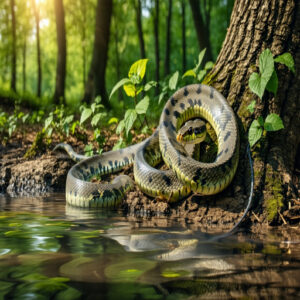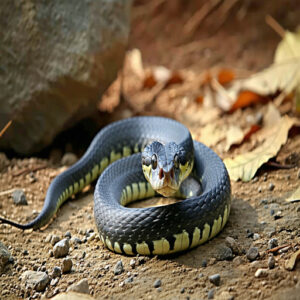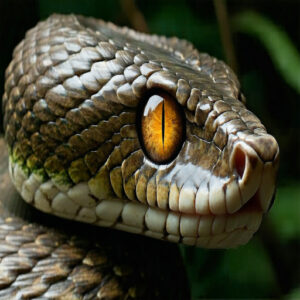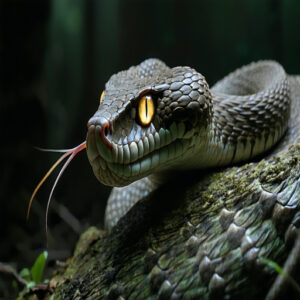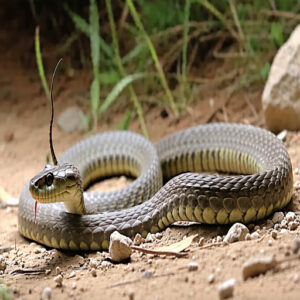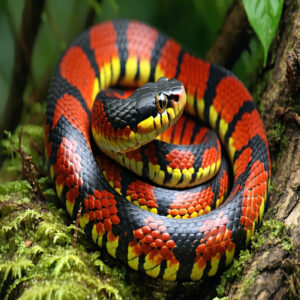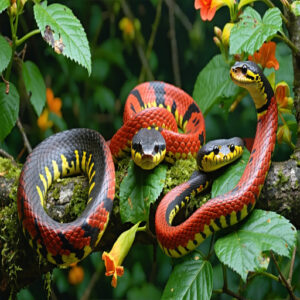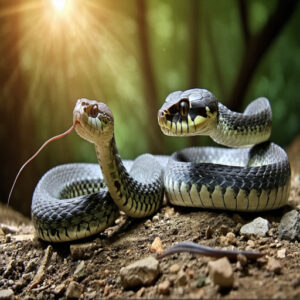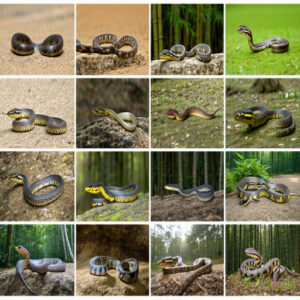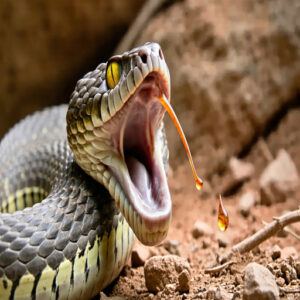This site is supported by our readers. We may earn a commission, at no cost to you, if you purchase through links.
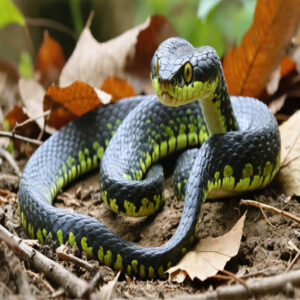 Figuring out how to tell if a snake is poisonous can be life-saving.
Figuring out how to tell if a snake is poisonous can be life-saving.
Look for a triangle-shaped head, cat-like elliptical pupils, and heat-sensing pits between the eyes and nostrils—all signs of a venomous snake.
Bright, bold colors or rattling tails? Those are nature’s flashing warning signs.
Behavior helps too: if a snake coils defensively, shakes its tail, or acts aggressive, it might be dangerous.
And remember—two fang marks on bites usually scream "venom"! But not all venomous snakes fit the mold, and some harmless ones mimic the dangerous types.
Watch your step out there!
Table Of Contents
- Key Takeaways
- Venom Vs. Poison: Key Differences in Snakes
- Physical Characteristics of Venomous Snakes
- Behavioral Clues to Identify Venomous Snakes
- Exceptions to Common Venomous Snake Rules
- Identifying Venomous Snake Bites
- Safe Practices for Snake Encounter Prevention
- First Aid for Suspected Venomous Snake Bites
- Frequently Asked Questions (FAQs)
- Are Venomous Snakes More Aggressive Than Non-Venomous Snakes?
- Are Venomous Snakes Faster Than Non-Venomous Snakes?
- Are Venomous Snakes More Difficult to Catch?
- Do All Venomous Snakes Have a Rattler?
- Can Non-Venomous Snakes Bite?
- What is the Difference Between Venom and Poison?
- What Should I Do if I Encounter a Venomous Snake?
- Are There Any Venomous Snakes in North America?
- Is It Safe to Handle the Head of a Dead Snake?
- What are 3 ways to determine if a snake is venomous?
- Conclusion
Key Takeaways
- Look for triangular-shaped heads, slit-like pupils, and heat-sensing pits between the eyes and nostrils—these are signs of venomous snakes.
- Pay attention to coiling defensively, rattling tails, or aggressive actions often indicate danger.
- Remember, venom is injected (like a snake bite), while poison is absorbed or ingested; snakes are venomous, not poisonous.
- Bright, bold colors or patterns and distinct rattling sounds are nature’s warning signals to steer clear.
Venom Vs. Poison: Key Differences in Snakes
Don’t worry, you’re not the only one who’s mixed up venom and poison—they’re not the same thing.
Venom is injected, like a snake bite, while poison is absorbed or eaten.
So knowing the difference could actually save your life, and understanding poison is crucial.
Definition of Venom and Poison
Ever wonder about venom vs poison?
Here’s the deal: venom is injected—like a snake bite; poison is absorbed or eaten—like touching a toxic frog.
Snakes use venom, never poison.
It’s toxicology basics 101!
Understanding snake venom types is essential in differentiating between various venomous species.
| Venom | Poison | Example |
|---|---|---|
| Injected | Absorbed/Ingested | Snake Bite |
| Direct Delivery | Passive Contact | Poison Dart Frog |
| Needs Antivenom | No Antivenom | Pufferfish |
Misconceptions About Venomous Snakes
Not all snakes are villains, people assume every snake is deadly or aggressive—Snake Myth Busting 101 says otherwise.
Most are shy unless threatened, you’ve heard about sucking venom out, right, pure movie magic.
Actually, not all bites inject venom (yep, “dry bites” exist).
Check out this table to rethink some common Snake Legends:
| The Truth |
|---|
| All snakes are venomous. |
Stay calm, snake-savvy, and think of snakes as misunderstood neighbors, not lurking fiends, considering the truth about venomous species.
Importance of Correct Terminology
Calling a snake “poisonous” instead of “venomous” isn’t just a word mix-up—it’s a safety risk.
Venomous snakes inject toxins; poisonous ones harm if eaten. Using the right terms sharpens snake identification and first aid.
Check it out:
| Example |
|---|
| Venomous |
Clear lingo saves lives—inject, don’t ingest!
Physical Characteristics of Venomous Snakes
You can spot a venomous snake by paying close attention to its head shape, eyes, and even its patterns.
Some tricks, like noticing a triangular head or slit-like pupils, might save you, but don’t let mimicry fool you!
Triangular Head Shape
That triangle-shaped head on a snake isn’t just for show—it’s a potential danger sign.
A venomous snake head shape, like a triangle, comes from venom glands, creating that broad structure.
But here’s the twist: some harmless snakes mimic this triangular head shape by flattening their heads.
Always pair the snake morphology with behavior and habitat clues to be sure!
Understanding venomous snake identification is essential for safe encounters.
Elliptical Pupil Shape
If the head shape didn’t clue you in, take a look at its eyes.
Venomous snakes have elliptical pupils—like a cat’s—that let them hunt in low light.
This pupil variation might seem small, but it’s a big deal for spotting danger.
Just don’t get too close when checking; it’s not worth risking a stare-off with a venomous snake!
Heat-Sensing Pits in Pit Vipers
Pit vipers come with built-in heat-sensing pits, like nature’s night-vision goggles.
These clever organs, tucked between the eyes and nostrils, help them track warm-blooded prey, even in the pitch dark.
This fascinating trait, part of Pit Viper Anatomy, showcases incredible evolution.
When paired with their triangular head and elliptical pupils, these venomous predators become masters of silent, precise hunting.
Coloration and Pattern Variations
Bright snake colors or bold patterns, known as aposematic signals, scream "Stay away!"—Mother Nature’s warning label.
But don’t trust snake colors alone, clever harmless species often use pattern mimicry to pose as their venomous cousins.
Watch for venomous markings, but remember—color variations can be deceiving.
Whether it’s snake patterns or reptile camouflage, always rely on other clues, too.
Tail Features (e.g., Rattles)
Sometimes, a snake’s tail speaks volumes.
Rattlesnakes, for example, create their iconic rattle sounds to say, “Back off!” But not every rattling tail means danger—clever, non-venomous snakes can fake it.
Look for these giveaway clues:
- Distinct tail vibrations paired with a rattle noise.
- Noticeable tail shape differences unique to venomous snakes.
- Rhythmic snake rattles that warn when threatened.
Snakes exhibiting tail rattle behavior can be especially misleading to the untrained eye.
See the warning? Keep your distance!
Behavioral Clues to Identify Venomous Snakes
When a snake starts coiling or rattling its tail, it’s probably telling you to back off.
Paying attention to these behaviors can help you spot a venomous snake before it’s too late.
Defensive Postures and Coiling
Spotting a snake coiled in those tight S-shaped loops is like seeing a warning light flash.
It’s their version of "Back off, buddy!"
Pay attention to their body language, because venomous snakes mean business when they’re wound up like this.
Look for:
- Tense, locked posture, ready to lunge.
- Sharp head movements, keeping you in sight.
- Shifting weight, like an athlete before a sprint.
- Raised, strike-ready stance, primed to defend.
- Intense eyes, locked onto your every move.
Respect these defensive postures—they’re no joke!
Rattling or Tail Shaking
Think rattlesnakes are the only ones with a tail shake warning? Nope! Loads of snakes use tail-shaking to shout, "Stay back!" Rattlers deliver that classic snake rattle noise, like maracas on overdrive.
Others? They’ll vibrate their tails against leaves to mimic danger. Understanding venomous snake identification is vital for safely traversing snake habitats.
Check out the quick comparison below:
| Warning Purpose |
|---|
| Rattlesnake |
Bottom line: that rattling sound’s a loud, “Don’t mess with me!”
Aggressive Vs. Defensive Behaviors
Tail vibrations and bold threat displays can feel nerve-wracking, but they’re often just warning behaviors.
Snakes show snake posturing like coiling up to say, “Back off!” without wanting to strike.
Aggressive behaviors like sudden strikes and hissing? That’s their attack mode kicking in, a sharp warning sign.
Spot these moves, respect their space, and keep snake safety in mind.
Habitat Preferences of Venomous Species
Looking to avoid venomous snake species? Pay attention to their favorite hangouts.
Desert habitats and rocky outcrops attract rattlesnakes.
Wetland areas, like ponds, are home to cottonmouths.
Forest ecosystems and grassland regions? Copperheads might be lurking.
Geographic differences impact snake habitats too—watch for signs if you’re in their zone.
Understanding snakebite risk models is essential for identifying high-risk areas.
Wherever you go, remember: understanding poisonous snake habitats boosts safety and confidence outdoors.
Exceptions to Common Venomous Snake Rules
You’ve probably heard rules like “triangular heads mean danger” or “bright colors are a warning,” but snakes love breaking the rules.
Some harmless ones wear scary costumes, while a few venomous ones look way too friendly—so it’s tricky, and you’ve got to stay sharp!
Coral Snakes: Round Pupils and Coloration
Coral snakes shake things up with round pupils, breaking the venomous snake stereotype.
Their bold coral snake patterns—red, yellow, and black—are nature’s red flag.
Here’s the rhyme you can’t forget: “Red touches yellow, kills a fellow.”
Unlike snake mimicry tactics, these red band signals tell you it’s no bluff—stay back!
Watch for venomous snake eyes and distinct coral snake behavior.
Non-Venomous Mimics of Dangerous Species
Nature’s tricksters, like the scarlet king snake, thrive on mimicry patterns to fool threats.
With clever color imitation and aposematic coloring, these harmless copies impersonate venomous species like coral snakes.
Don’t fall for these fake threats—remember, true coral snakes have red touching yellow bands.
Snake mimicry can be convincing, but spotting these harmless snake imposters might just save your hide!
Variations in Head Shape Among Species
A triangular head doesn’t always point to venomous snake head traits—it’s nature’s little bluff.
Many harmless snakes, like hognose snakes, flatten their heads to mimic the venomous snake head shape and scare off predators.
So, don’t jump to conclusions based solely on shape.
- Mimic tactics: Nature’s master trick.
- Snake skull anatomy differences: Subtle, but key.
- Triangular heads explained: Not always dangerous.
- Species identification matters: Know local snakes.
Geographic Differences in Snake Characteristics
Not all venomous snakes play by the same rules—they adapt to their surroundings as creatively as nature allows.
Geographic differences shape their looks, habits, and venom, so knowing regional quirks can save you a heap of trouble.
Let’s break it down.
Here’s a handy table to map it out:
| Eye Shape | |
|---|---|
| North America | Moderate |
From desert species blending into dusty landscapes to vibrant vipers in tropical habitats, where they come from shapes how they act.
Regional snake variation is key regarding snake identification tips.
Snakes near coastal ecosystems or high in mountain ecosystems bring their own dangerous flair.
Identifying Venomous Snake Bites
When a venomous snake bites, it often leaves distinctive fang marks and symptoms that can hit fast or show up later.
Knowing the difference between a dangerous bite and a harmless one could be the difference between panic and staying safe.
Fang Mark Patterns
Two fang marks are a dead giveaway of a venomous bite.
These bite wounds come from snake fangs designed for venom delivery.
You’ll usually spot:
- Two deep punctures – spaced apart, matching the fang tooth structure.
- Swelling around the marks – venom’s calling card.
- Smaller teeth imprints nearby – harmless, except for the fangs’ venomous touch.
Stay alert!
Immediate and Delayed Symptoms
Pain hits differently depending on the venom.
That bite could feel like fire burning or a nagging ache.
Swelling shows up fast, followed by nausea or weak muscles.
Watch for breathing trouble—it’s a red flag screaming for an emergency response.
Remember, a venomous snake bite mark might take hours to fully show its toxicology effects.
Stay alert!
Differences in Venom Types and Effects
Snake bites aren’t one-size-fits-all.
Different venom types hit you in unique ways, Neurotoxins mess with your nerves, causing paralysis, while hemotoxins damage tissue and blood.
Then there are cytotoxins, which destroy cells like little wrecking balls.
Venom classification helps doctors pick the right treatment, nail down these venomous snake characteristics, and you’ll know what’s coming—or at least what might.
Dry Bites Vs. Envenomation
Here’s a surprise about bite symptoms – up to 25% of venomous snake bites are "dry bites" with no venom injection at all.
But you’ll still need medical care to be safe.
Watch for these envenomation signs that mean venom’s at work:
- Quick swelling and intense pain at the bite site
- Tingling or numbness spreading from the area
- Trouble breathing or dizziness
- Changes in heart rate or blood pressure
This information is crucial for understanding the risks associated with venomous snake bites.
Safe Practices for Snake Encounter Prevention
You don’t need to be a snake expert to stay safe – just a few simple habits can keep these scaly neighbors at a comfortable distance.
Whether you’re hiking through their territory or tidying up your yard, you’ll learn the essential prevention tips that’ll help you avoid those awkward (and potentially dangerous) snake encounters.
Proper Attire for Snake-Prone Areas
Your best defense against bites starts with proper protective clothing.
Wear thick leather hiking boots that rise at least 2 inches above your ankles, paired with waterproof socks and long pants.
Add snake guards or gaiters for extra protection – they’ll keep dirt out too.
Choosing the right hiking boots material is essential for durability.
Choose light-colored gear to spot movement easily, and don’t forget sturdy gloves for your hands.
Awareness of Surroundings and Snake Habitats
While good boots protect your feet, smart habitat awareness can save your life.
Stay extra watchful around rocky outcrops, fallen logs, and water edges – these spots are like five-star hotels for our scaly friends.
Your spatial alertness matters most during morning hours when they’re basking in sunny patches.
Different regions mean different behaviors – desert dwellers act nothing like their forest cousins.
Want a pro tip? Local wildlife guides know exactly which snake habitats to watch for in your area.
Understanding snake safety precautions is key to minimizing the risk of encounters with venomous species.
Yard Maintenance to Deter Snakes
A well-maintained yard isn’t just about curb appeal – it’s your first line of defense against unwanted serpentine visitors.
Trim grass regularly, remove leaf litter, and keep woodpiles far from your house.
Plant natural deterrents like marigolds or lemongrass around your property’s perimeter.
Remember to seal gaps in foundations and install snake-proof yard fencing to guarantee maximum protection.
Pro tip: Position bird feeders away from your house to avoid attracting rodents that snakes love to hunt.
Proper Reaction When Encountering a Snake
Many people freeze up during a surprise snake encounter, but staying calm is your strongest defensive measure.
If you spot one, give it space and back away slowly – no sudden moves that might trigger its warning signs.
Keep your eyes on the snake without making direct eye contact, and remember emergency protocols: if it’s in your yard, call local wildlife services for proper snake safety.
While waiting for help, observe from a safe distance to aid in venomous snake identification.
Most snakes would rather avoid attacks than fight, so respect their space and they’ll likely slither away peacefully.
First Aid for Suspected Venomous Snake Bites
You’ll need to act fast if you’ve been bitten by a venomous snake, but don’t panic – knowing the right first aid steps can save your life.
While you’re waiting for emergency help to arrive, you can take simple actions that’ll give you the best chance of recovery, like keeping still and removing any jewelry that might cause problems if swelling occurs, this includes actions like keeping still.
Immediate Actions After a Bite
When danger strikes in the form of a bite, your immediate bite response can make all the difference.
Stay calm and activate your emergency kit protocol – panicking won’t help those snake bite symptoms.
First, immobilize the affected area and quickly remove any jewelry before swelling sets in.
For proper wound cleaning, use soap and water gently at the site.
While following these medical protocols, try to remember the snake’s appearance for venomous snake identification.
Keep the bitten area level with your heart and remember – your calm action now helps venom remedies work better later.
Do’s and Don’ts of Snake Bite Treatment
Quick actions make all the difference in snake bite treatment.
Keep the bite area still and stay cool – panicking won’t help.
Remember your first aid basics:
- Gently clean the wound with soap and water, then cover with a clean bandage
- Take off rings and watches before swelling starts
What not to do:
- Skip old myths like tourniquets or trying to suck out venom
- Don’t use ice or cut the bite area
It’s also essential to have a snake bite kit on hand for emergency situations.
Stay calm and let the experts handle it.
Importance of Prompt Medical Attention
Time stands between life and death when you’re dealing with a snake bite.
Every minute counts in the emergency response time, as venom spreads through your system.
Don’t waste precious moments trying home remedies – medical professionals know that rapid intervention dramatically improves treatment outcomes.
You’ll want to dial emergency services immediately and stay calm while help arrives.
Antivenom effectiveness peaks when administered early, so getting to a hospital fast is your top priority.
Remember, venom effects can escalate quickly, but prompt medical attention gives you the best fighting chance.
Identifying The Snake for Treatment Purposes
To get the right antivenom quickly, you’ll need to help doctors identify what bit you.
While at the hospital, describe the snake’s unique features – its head shape, eye pupils, and any distinct color patterns you noticed.
Don’t worry if you missed some details; even partial descriptions of bite marks and venom symptoms can guide medical teams in choosing the correct treatment.
Regional knowledge of local snake species also helps narrow it down.
Frequently Asked Questions (FAQs)
Are Venomous Snakes More Aggressive Than Non-Venomous Snakes?
Venomous snakes aren’t always more aggressive, but they defend themselves fiercely if threatened.
Many stay still or retreat unless provoked.
Give them space—no snake wants to waste venom on something it can’t eat!
Are Venomous Snakes Faster Than Non-Venomous Snakes?
Imagine this: snakes aren’t Usain Bolt on the track.
Venomous snakes aren’t always faster than their harmless cousins.
Speed depends on species and situation, but both can strike terrifyingly quick—so keep your distance either way!
Are Venomous Snakes More Difficult to Catch?
Catching a venomous snake can be trickier because they’re generally more defensive and quicker to strike when threatened.
Their behaviors, like coiling or rattling, make them unpredictable.
Always prioritize safety—you’re not a snake wrangler!
Do All Venomous Snakes Have a Rattler?
About 70% of snake species are non-venomous.
No, not all venomous snakes have a rattler, rattlesnakes do, but others, like copperheads or coral snakes, rely on stealth or sharp colors instead.
Can Non-Venomous Snakes Bite?
Non-venomous snakes can bite, and while their bites aren’t dangerous, they can still hurt and cause infections.
Treat the wound with soap, water, and antiseptic.
It’s their way of saying, “Stay back, buddy!”
What is the Difference Between Venom and Poison?
Think of venom as a hypodermic needle—it’s injected, like a snake bite.
Poison is more like bad food—you ingest, inhale, or touch it.
Both are dangerous, but venom gets under your skin—literally!
What Should I Do if I Encounter a Venomous Snake?
Stay calm and slowly back away—no sudden movements.
Give the snake space to escape.
Don’t poke or provoke it, and definitely don’t try to catch it.
Consider it your cue to leave nature’s stage!
Are There Any Venomous Snakes in North America?
You’ve got plenty to watch out for!
North America’s venomous snakes include rattlesnakes, copperheads, cottonmouths, and coral snakes.
They’re sneaky, but knowing their traits and hanging out where they live can keep surprises to a minimum, especially with snakes.
Is It Safe to Handle the Head of a Dead Snake?
It’s not safe.
A dead snake’s head can still bite and inject venom if touched.
Treat it like it’s alive—keep your distance.
Think twice before getting close, even if it looks harmless.
What are 3 ways to determine if a snake is venomous?
Over 600 snake species worldwide pack venom, but here’s how to spot danger: triangular heads often scream venom, slit-like pupils are sketchy.
If it’s rattling? Step back—it’s not composing a song for you.
Conclusion
Not sure if that snake’s poisonous? Don’t panic—remember the key signs: triangle-shaped head, elliptical pupils, heat-sensing pits, and bold warning colors.
Be cautious around coiled or rattling snakes, and keep an eye out for fang marks if bitten.
Some harmless snakes mimic the dangerous ones, so stay sharp.
Knowing how to tell if a snake is poisonous can save your life, and respecting their space, staying alert, and being snake-smart will help you avoid an unwanted encounter.
Stay safe and snake-smart!
- https://www.terminix.com/blog/education/how-to-tell-if-a-snake-is-poisonous/
- https://urbanjunglewildliferemoval.com/blog/how-to-tell-venomous-snake/
- https://www.snakesox.com/blog/2019/6/20/4-ways-to-tell-if-a-snake-is-venomous
- https://www.quora.com/Can-you-tell-if-a-snake-is-poisonous-by-its-eyes
- https://en.wikipedia.org/wiki/Aposematism

